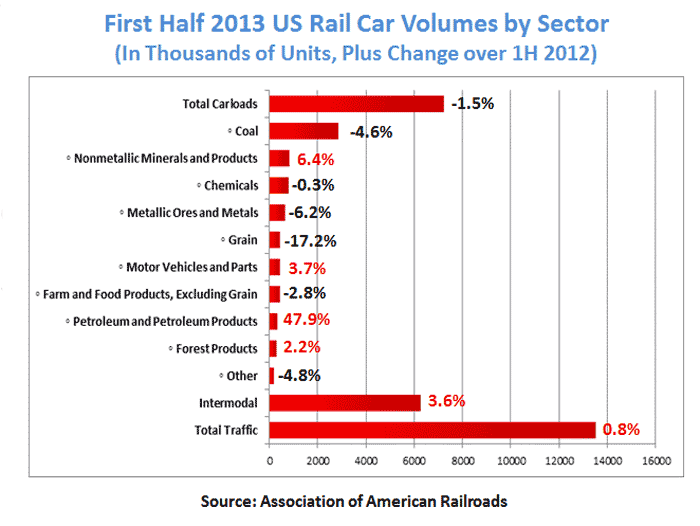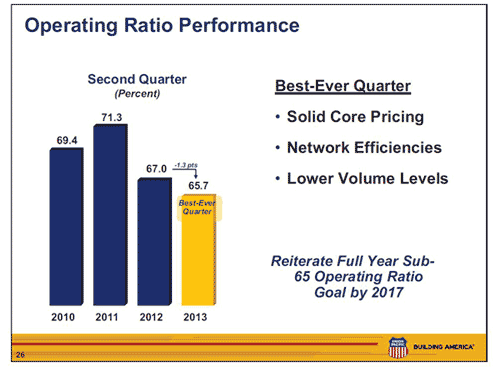From SCDigest's On-Target E-Magazine
- July 24, 2013 -
Logistics News: Union Pacific Separates Itself from the Pack in Q2
UP Delivers Record Profits even as Industry Volumes Mostly Flat, While Rate Increases Continue Apace; Profit Levels Now Among Best Across All Business Segments
SCDigest Editorial Staff
In a clearly slowing environment in terms of overall volumes, the four publicly traded US rail carriers had somewhat different fates in Q2, as Union Pacific blew most of its competition out of the water. Those details here this week as part of our quarterly review of results and trends across major transportation modes, starting with rail carriers. Truckload and LTL results will be coming next over the next couple of weeks, as the publicly traded carriers in those sectors finish up their Q2 reports.
SCDigest Says: |
 |
| Those are numbers that would be welcome by virtually any other business sector, as the industry has moved in the past decade from having one of the worst returns on invested capital to one of the best. |
|
What Do You Say?
|
|
|
|
Like all modes of transportation, the rail sector is very dependent on factors outside of its control. Those include the overall economy (weak during Q2, with US GDP growth of likely just 1% or so), environmental regulations (which have been significantly pushing utilities away from use of goal), import volumes (which impact intermodal volumes) and more.
According to the Association of American Railroads (AAR), total rail volumes were up just .8% in the first half, as shown in the graphic below. But that basically flat volume through the end of June belied a lot of dynamics within that total. (Note these numbers do not include the volumes of Canadian railroads operating in the US.)
Intermodal traffic was up 3.6% in the first half of the year, while traditional rail car loads were down 1.5%. All told, that led to a total traffic gain of just 0.8% in the quarter.
Coal volumes continue to shrink, down 4.6%, though that is better than the mid-double-digit decreases seen over many recent quarters. But suddenly those losses in coal for some rail carriers are being made up in part by sharp increases in oil shipments from booming US oil production and restrictions on new pipeline construction.
And coal has a huge impact on the rail industry's fortunes, though that varies by carrier. Even with recent sharp declines over the last 18 months or so year-over-year, coal still accounted for 39.4% of total car load volumes in the first half. While oil volumes have grown 47.9% in the first half, the total oil car loads were only about 11% of coal volumes.
Given that, the overall results for the rail sector were still fairly impressive, as pricing power appears to remain in place - though perhaps more so for some than others.

In recent years, the rail carriers have overall largely move in lock step, but that changed in Q2, when Union Pacific was ascendant, at least in terms of the bottom line. UP saw profits rise to record territory, up 10.4%year over year even though car load volumes actually fell 1%.(See Q2 results table below.)
Rail Carrier Q2 2013 Results

See Full Size Image
In its earnings report, Union Pacific said its rates were up about 5% yet again in Q2.
CSX saw profits up 4.5%, while Norfolk Southern saw profits down 11.3%, and Kansas City Southern saw profits tumble some 87%, though this was primarily due to some one-time, non-operational issues.
In fact, KCS's operating ratio (operating costs versus operating revenues) came in at a strong 69%, though Union Pacific led the way with an OR of an amazing 65.7%, simply unimaginable in this industry until the past few years. UP reiterated its goal of achieving an operating goal of below 65% by 2017. (See graphic below.)
Union Pacific Plans to Drive Record Operating Ratios Even Lower

By contrast, leading truckload carriers have ORs in the mid-80% range at best, and less-than-truckload carriers, with the exception of Old Dominion, struggle to get below 95%.
(Transportation Management Article Continued Below)
|